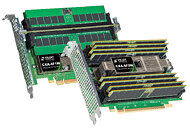- Joined
- Oct 9, 2007
- Messages
- 47,949 (7.37/day)
- Location
- Dublin, Ireland
| System Name | RBMK-1000 |
|---|---|
| Processor | AMD Ryzen 7 5700G |
| Motherboard | Gigabyte B550 AORUS Elite V2 |
| Cooling | DeepCool Gammax L240 V2 |
| Memory | 2x 16GB DDR4-3200 |
| Video Card(s) | Galax RTX 4070 Ti EX |
| Storage | Samsung 990 1TB |
| Display(s) | BenQ 1440p 60 Hz 27-inch |
| Case | Corsair Carbide 100R |
| Audio Device(s) | ASUS SupremeFX S1220A |
| Power Supply | Cooler Master MWE Gold 650W |
| Mouse | ASUS ROG Strix Impact |
| Keyboard | Gamdias Hermes E2 |
| Software | Windows 11 Pro |
SMART Modular Technologies, Inc. ("SMART"), a Penguin Solutions, Inc. brand (Nasdaq: PENG) and a global leader in integrated memory solutions, solid-state drives, and hybrid storage products, today announced that its 4-DIMM and 8-DIMM CXL (Compute Express Link ) memory Add-in Cards (AICs) have successfully passed CXL 2.0 compliance testing. These products are now officially listed on the CXL Consortium's Integrators' List, marking a significant milestone in the company's commitment to delivering high-quality, interoperable memory solutions.
The inclusion of SMART Modular Technologies' products on the CXL Integrator's List underscores the company's dedication to adhering to industry standards and ensuring compatibility across a wide range of computing environments. The CXL Compliance Program, developed by the CXL Consortium, provides members with opportunities to test the functionality and interoperability of their products as defined in the CXL specification. This achievement not only highlights SMART Modular Technologies' technical expertise, but also reinforces its role as a leader in advancing integrated memory technology.

"Achieving CXL compliance is a testament to our team's hard work and dedication to innovation," stated Andy Mills, vice president of advanced product development at SMART Modular Technologies. "Our 4-DIMM and 8-DIMM CXL memory Add-in Cards are designed to meet the evolving needs of our customers, and this recognition further validates our commitment to providing cutting-edge solutions with enhanced performance and reliability."
As the demand for high-speed data processing continues to grow, SMART Modular Technologies remains at the forefront of delivering advanced memory solutions that help drive efficiency and performance in modern computing systems.
View at TechPowerUp Main Site
The inclusion of SMART Modular Technologies' products on the CXL Integrator's List underscores the company's dedication to adhering to industry standards and ensuring compatibility across a wide range of computing environments. The CXL Compliance Program, developed by the CXL Consortium, provides members with opportunities to test the functionality and interoperability of their products as defined in the CXL specification. This achievement not only highlights SMART Modular Technologies' technical expertise, but also reinforces its role as a leader in advancing integrated memory technology.

"Achieving CXL compliance is a testament to our team's hard work and dedication to innovation," stated Andy Mills, vice president of advanced product development at SMART Modular Technologies. "Our 4-DIMM and 8-DIMM CXL memory Add-in Cards are designed to meet the evolving needs of our customers, and this recognition further validates our commitment to providing cutting-edge solutions with enhanced performance and reliability."
As the demand for high-speed data processing continues to grow, SMART Modular Technologies remains at the forefront of delivering advanced memory solutions that help drive efficiency and performance in modern computing systems.
View at TechPowerUp Main Site



